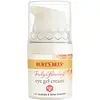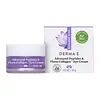What's inside
What's inside
 Key Ingredients
Key Ingredients

 Benefits
Benefits

 Concerns
Concerns

 Ingredients Side-by-side
Ingredients Side-by-side

Water
Skin ConditioningGlycerin
HumectantMango Butter Dimer Dilinoleyl Esters/Dimer Dilinoleate Copolymer
EmollientBentonite
AbsorbentCaprylic/Capric Triglyceride
MaskingUndecane
EmollientC10-18 Triglycerides
EmollientBeeswax
Emulsion StabilisingInulin
Skin ConditioningSqualane
EmollientCandelilla/Jojoba/Rice Bran Polyglyceryl-3 Esters
EmulsifyingGlyceryl Stearate
EmollientTridecane
PerfumingCarthamus Tinctorius Seed Oil
MaskingSimmondsia Chinensis Seed Oil
EmollientHydrolyzed Hyaluronic Acid
HumectantCetearyl Alcohol
EmollientSodium Stearoyl Lactylate
EmulsifyingSilica
AbrasiveTocopherol
AntioxidantSodium PCA
HumectantXanthan Gum
EmulsifyingParfum
MaskingCitric Acid
BufferingPotassium Sorbate
PreservativeLecithin
EmollientSclerotium Gum
Emulsion StabilisingSodium Phytate
Pullulan
Alcohol
AntimicrobialPhenoxyethanol
PreservativeEthyl Lauroyl Arginate Hcl
Skin ConditioningWater, Glycerin, Mango Butter Dimer Dilinoleyl Esters/Dimer Dilinoleate Copolymer, Bentonite, Caprylic/Capric Triglyceride, Undecane, C10-18 Triglycerides, Beeswax, Inulin, Squalane, Candelilla/Jojoba/Rice Bran Polyglyceryl-3 Esters, Glyceryl Stearate, Tridecane, Carthamus Tinctorius Seed Oil, Simmondsia Chinensis Seed Oil, Hydrolyzed Hyaluronic Acid, Cetearyl Alcohol, Sodium Stearoyl Lactylate, Silica, Tocopherol, Sodium PCA, Xanthan Gum, Parfum, Citric Acid, Potassium Sorbate, Lecithin, Sclerotium Gum, Sodium Phytate, Pullulan, Alcohol, Phenoxyethanol, Ethyl Lauroyl Arginate Hcl
Water
Skin ConditioningGlycerin
HumectantCaprylic/Capric Triglyceride
MaskingMacadamia Ternifolia Seed Oil
EmollientStearic Acid
CleansingCetyl Alcohol
EmollientGlyceryl Stearate
EmollientHydroxypropyl Cyclodextrin
MaskingPalmitoyl Tripeptide-38
Skin ConditioningAcetyl Hexapeptide-8
HumectantPanthenol
Skin ConditioningPinus Pinaster Bark Extract
AntioxidantAcacia Seyal Gum Extract
HumectantTocopheryl Acetate
AntioxidantRetinyl Palmitate
Skin ConditioningAscorbyl Palmitate
AntioxidantHamamelis Virginiana Extract
AntiseborrhoeicAesculus Hippocastanum Seed Extract
Skin ConditioningCamellia Sinensis Leaf Extract
AntimicrobialChamomilla Recutita Flower Extract
MaskingSimmondsia Chinensis Seed Oil
EmollientAllantoin
Skin ConditioningDimethicone
EmollientXanthan Gum
EmulsifyingZinc Oxide
Cosmetic ColorantPotassium Sorbate
PreservativePhenoxyethanol
PreservativeEthylhexylglycerin
Skin ConditioningWater, Glycerin, Caprylic/Capric Triglyceride, Macadamia Ternifolia Seed Oil, Stearic Acid, Cetyl Alcohol, Glyceryl Stearate, Hydroxypropyl Cyclodextrin, Palmitoyl Tripeptide-38, Acetyl Hexapeptide-8, Panthenol, Pinus Pinaster Bark Extract, Acacia Seyal Gum Extract, Tocopheryl Acetate, Retinyl Palmitate, Ascorbyl Palmitate, Hamamelis Virginiana Extract, Aesculus Hippocastanum Seed Extract, Camellia Sinensis Leaf Extract, Chamomilla Recutita Flower Extract, Simmondsia Chinensis Seed Oil, Allantoin, Dimethicone, Xanthan Gum, Zinc Oxide, Potassium Sorbate, Phenoxyethanol, Ethylhexylglycerin
Ingredients Explained
These ingredients are found in both products.
Ingredients higher up in an ingredient list are typically present in a larger amount.
This ingredient is an emollient, solvent, and texture enhancer. It is considered a skin-softener by helping the skin prevent moisture loss.
It helps thicken a product's formula and makes it easier to spread by dissolving clumping compounds.
Caprylic Triglyceride is made by combining glycerin with coconut oil, forming a clear liquid.
While there is an assumption Caprylic Triglyceride can clog pores due to it being derived from coconut oil, there is no research supporting this.
Learn more about Caprylic/Capric TriglycerideGlycerin is already naturally found in your skin. It helps moisturize and protect your skin.
A study from 2016 found glycerin to be more effective as a humectant than AHAs and hyaluronic acid.
As a humectant, it helps the skin stay hydrated by pulling moisture to your skin. The low molecular weight of glycerin allows it to pull moisture into the deeper layers of your skin.
Hydrated skin improves your skin barrier; Your skin barrier helps protect against irritants and bacteria.
Glycerin has also been found to have antimicrobial and antiviral properties. Due to these properties, glycerin is often used in wound and burn treatments.
In cosmetics, glycerin is usually derived from plants such as soybean or palm. However, it can also be sourced from animals, such as tallow or animal fat.
This ingredient is organic, colorless, odorless, and non-toxic.
Glycerin is the name for this ingredient in American English. British English uses Glycerol/Glycerine.
Learn more about GlycerinGlyceryl Stearate is a mix of glycerin and stearic acid.
It is used to stabilize the mixing of water and oil ingredients. By preventing these ingredients from separating, it can help elongate shelf life. It can also help thicken the product's texture.
As an emollient, it helps soften skin and supports barrier-replenishing ingredients.
In cosmetics, Glyceryl Stearate is often made from vegetable oils or synthetically produced.
This ingredient may not be fungal-acne safe
Fun fact: The human body also creates Glyceryl Stearate naturally.
Learn more about Glyceryl StearatePhenoxyethanol is a preservative that has germicide, antimicrobial, and aromatic properties. Studies show that phenoxyethanol can prevent microbial growth. By itself, it has a scent that is similar to that of a rose.
It's often used in formulations along with Caprylyl Glycol to preserve the shelf life of products.
Potassium Sorbate is a preservative used to prevent yeast and mold in products. It is commonly found in both cosmetic and food products.
This ingredient comes from potassium salt derived from sorbic acid. Sorbic acid is a natural antibiotic and effective against fungus.
Both potassium sorbate and sorbic acid can be found in baked goods, cheeses, dried meats, dried fruit, ice cream, pickles, wine, yogurt, and more.
You'll often find this ingredient used with other preservatives.
Learn more about Potassium SorbateThis oil comes from the seeds of the desert shrub called Jojoba. It is more commonly known as jojoba oil, a non-comedogenic oil.
Jojoba oil does not contain fragrance and has many fatty-acids, making it a great soothing ingredient.
It also contains Vitamin E, a great moisturizing ingredient. Vitamin E is also an antioxidant and protects your skin against oxidative damage.
This ingredient humectant properties, meaning it helps draw moisture from the air. This helps keep your skin hydrated.
While jojoba has antibacterial properties, it is only able to kill some strains of bacteria.
Studies also show it helps in wound healing. In fact, Indigenous cultures have used jojoba as a moisturizer and to help treat burns for centuries.
Fun fact: Jojoba oil similar to natural human skin sebum, so it has a great effect on dry skin. It is also promising with helping to regulate sebum production.
Due to its fatty acid content, Jojoba oil may not be fungal acne safe. We recommend speaking with a professional if you have any concerns.
Learn more about Simmondsia Chinensis Seed OilWater. It's the most common cosmetic ingredient of all. You'll usually see it at the top of ingredient lists, meaning that it makes up the largest part of the product.
So why is it so popular? Water most often acts as a solvent - this means that it helps dissolve other ingredients into the formulation.
You'll also recognize water as that liquid we all need to stay alive. If you see this, drink a glass of water. Stay hydrated!
Learn more about WaterXanthan gum is used as a stabilizer and thickener within cosmetic products. It helps give products a sticky, thick feeling - preventing them from being too runny.
On the technical side of things, xanthan gum is a polysaccharide - a combination consisting of multiple sugar molecules bonded together.
Xanthan gum is a pretty common and great ingredient. It is a natural, non-toxic, non-irritating ingredient that is also commonly used in food products.
Learn more about Xanthan Gum